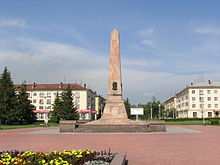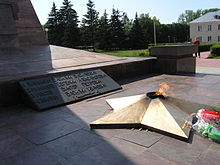- Obelisk of Glory (Tolyatti)
-
Coordinates: 53°30′48″N 49°24′34″E / 53.51333°N 49.40944°E
The Obelisk of Glory (Russian: Обелиск Славы) is a monument in Tolyatti's Liberty Square to the heroes of World War II (called, in Russia, the Great Patriotic War).
Contents
Creation
Due to the construction of the Zhiguli Hydroelectric Station in the early 1950s, the town of Stavropol (renamed Tolyatti in 1964) fell into the flooding zone of the new Kuybyshev Reservoir on the Volga River and was completely rebuilt on a new site.
Part of the plan for relocating Stavropol was to be an area dedicated to the memory of the poet Alexander Pushkin. But in in April 1957, some young builders proposed to instead erect a monument to the fighters of the Great Patriotic War, at their own expense. 30,000 rubles were amassed by collecting waste paper, scrap metal, and so forth.
A design competition was held, won by Mikhail Sorokin, who was awarded a ticket to the Sixth World Festival of Youth and Students in Moscow.
Sorokin's design was a classic four-sided stele. Three sides depict fighters of the Great Patriotic War who were residents of Stavropol (pilot Victor Nosov, infantry soldier Vasili Zilina, and seaman Eugene Nikonov) while the fourth depicts Vasili Banykina (1888-1918), an earlier figure, a former Chairman of the Executive Committee of the Stavropol City Council (equivalent to mayor) who was instrumental in establishing Bolshevik power in Stavropol and who had been shot while supervising the evacuation of the city in the face of the advancing Czechoslovak Legion.
The opening ceremony for the monument was October 26, 1958. Since that day, Liberty Square has been a central place of the city, and the name is also now used for the surrounding area. Since November 7, 1958, city celebrations and demonstrations have been held there. The adjacent parkway was named Youth Boulevard.
Restoration
In preparation for the 30th anniversary of victory in the Great Patriotic War, in April of 1975 the obelisk was restored and altered.
The four stone balls and the decorative chains at the perimeter were removed, and the monument was faced with granite. The existing medallions were replaced with bas-relief profiles of the heroes in bronze executed by Tolyatti artists A. N. Pronyushkin and N. Kolesnikov. On one side of the stele was placed a plaque with the inscription
“ They shall not perish from memory
Those fallen with honor
In the great battle
For an ideal, a principle.
No, but rather their names
Shall become sacred
In the victory songs
Sung by millions.” The phrase "Champions who died for the freedom and happiness of the people" was also added.
On November 3, 1978 the eternal flame was lit at the monument, delivered by an armored personnel carrier from the flame at the Obelisk of Glory in Samara. After this, the Toylatti monument gradually also came to be referred to as the Obelisk of Glory.
In 2006, the mayor of Tolyatti, Nikolai Utkin, declared his intention to refurbish the monument.
External links
- "Обелиск славы [Obelisk of Glory]". Names on a map of Tolyatti (Fragments from the history of Tolyatti). http://citytlt.narod.ru/alfops.htm. Retrieved April 4, 2011. (Russian)
- "Обелиск Славы [Obelisk of Glory]". Virtual Tolyatti. http://gorod63.ru/gallery/slide/monument/&n_2/. Retrieved April 12, 2011. (Russian)
Further reading
Ovsyannikov, V. A. (1997). Ставрополь — Тольятти. Страницы истории [Stavropol - Togliatti: Pages of History]. Part 1. Tolyatti: Univ Foundation for Development through Education. (Russian)
- This article incorporates information from the equivalent article on the Russian Wikipedia.
Categories:- Obelisks in Russia
- World War II memorials in Russia
- 1958 establishments in the Soviet Union
- Monuments in Tolyatti
- Buildings and structures completed in 1958
Wikimedia Foundation. 2010.


